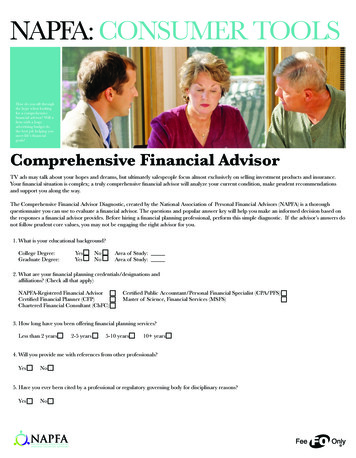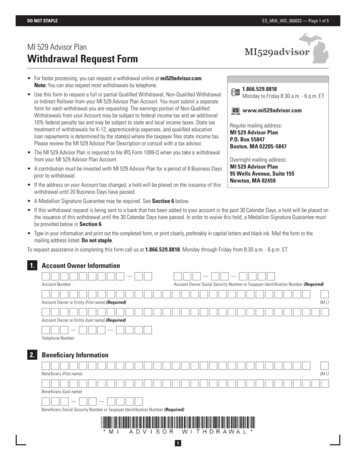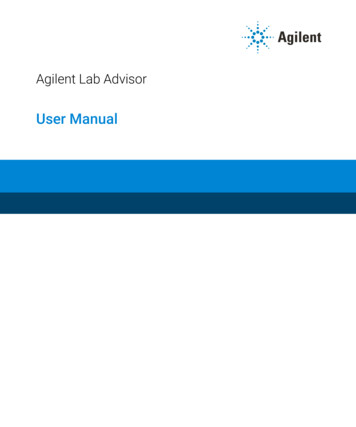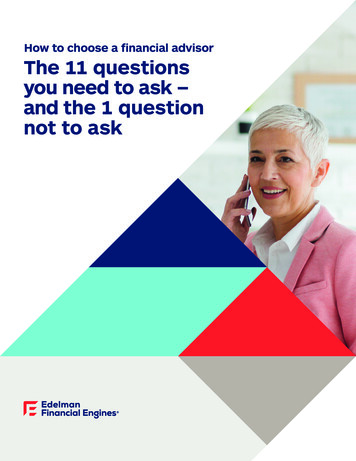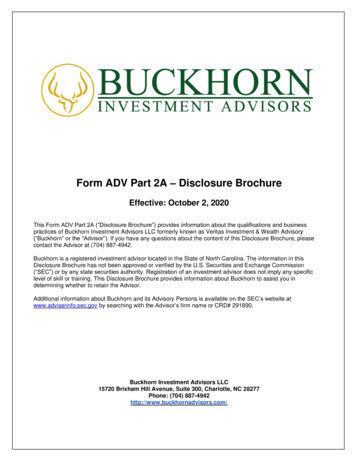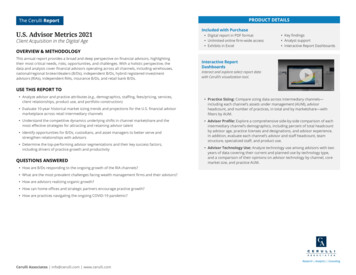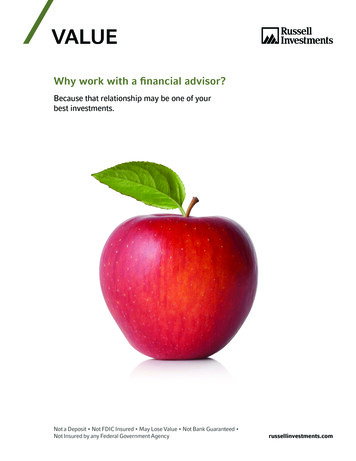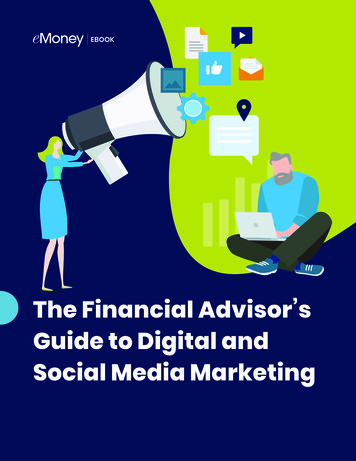
Transcription
EBOOKThe Financial Advisor’sGuide to Digital andSocial Media Marketing
GUIDE TO DIGITAL AND SOCIAL MEDIA MARKETINGMarketing is critical to building and maintaining a successful financial planningpractice. Imagine yourself in your prospect’s shoes for a moment: When theysearch online for an advisor, they find hundreds of potential matches in their area.Each advisor, from the prospect’s inexperienced perspective, is indistinguishablefrom the next. They likely have no idea how to evaluate a financial advisor or whatmakes one advisor a better fit than another in this saturated marketplace.A robust marketing strategy can help you position your value with your ideal client,and it can help you winnow out those who aren’t a good addition to your roster.However, not every advisor has prioritized marketing, and even those that havemay not be maximizing its potential benefits.The good news is that there is a significant opportunityto gain new clients in today’s financial climate. In a recentsurvey conducted by CNBC and Acorns 1,57% of Americans are more confident in their abilityto save for retirement than they were three years ago.Despite this growing confidence, this same group ofpotential investors says that saving for retirement is stilltheir top concern.That opportunity starts with the gap in how most peoplemanage their money and plan for the future. In the samesurvey, 75% of Americans said they currently managetheir money without the help of a financial advisor.That gap spans generations: Only 7% of the 25-34 agegroup and 31% of the 65 age group work witha financial advisor.Through marketing—specifically digital marketing—advisors can promote the true valueof wealth management.2
GUIDE TO DIGITAL AND SOCIAL MEDIA MARKETINGThe Digital Marketing Hurdles(and How to Overcome Them)Why aren’t financial advisors more savvy and aggressive when it comes to digital and social media marketing? Given thegap between the number of Americans who cite saving for retirement as a top concern and those who actually use financialadvisors to help with those plans, the opportunity for financial advisors is ripe.A recent benchmark study from InvestmentNews reveals that only 29% of advisory firms currently use a standalonemarketing tool, with another 25% planning to adopt one over the next year 2. These trends indicate that many advisorsrecognize the promise of better and more robust marketing programs, but may be facing hurdles that are too high to clearon their journey to finding new clients. eMoney identified several of those hurdles in our Next Best in Class Marketing ToolResearch report 3, surveying over 600 advisors with varying degrees of marketing experience and participation. Severalbarriers to marketing tool usage—indicative of deeper levels of marketing sophistication—emerged across advisors whoconsider themselves “mature” and “developing” marketers. These barriers include:Lack of time and resources:Marketing tools require an investmentto implement and have an associatedlearning curve. For small- andmedium-sized firms, the lack of adedicated resource to help withadministration and tracking cancomplicate usage.Unsupportive purchasedecision makers:Preference for referrals orpersonal client touches:Whether it’s a dedicated procurementteam, operational leader or otherdecision maker vetting new tools forthe firm, advisors may be challengedto demonstrate the value of amarketing tool—especially if that toolis new to them.The advisor-client relationship is builton trust and familiarity. Many advisorsfear that marketing tools and technologywill introduce an artificial layer to theserelationships and potentially underminethat personal touch.Solutions to these hurdles are built into many of the digital marketing tools that financial advisors may be using.For instance, the ability to automate a marketing program can solve the limited time and resources problem. Ifan advisor wants to nurture a prospect through a series of emails that provide helpful advice and insights thatbuild credibility, automation can create a series of time- or event-triggered communications to that prospect.The automation program will need to be created once, but it can be used again with new prospects who will thenrun through the same program—essentially a “set it and forget it” approach.
GUIDE TO DIGITAL AND SOCIAL MEDIA MARKETINGFor decision makers who are reluctant to approve a new digital marketing tool, advisors can demonstrate how that toolwill help to improve efficiency around traditionally challenging marketing issues like FINRA compliance. Many digitalmarketing tools allow firms to centralize their control over the distribution of content through a variety of channels,including email and social media. Advisors can pick and choose from approved content to share with a prospect, withthe assurance that what they’re sending is compliant and safe.A preference for a more personal touch and better understanding can also be solved in part by digital marketing tools.Of course, they’ll never replace a phone call or face-to-face meeting for truly personal interaction with a client orprospect, but they can help keep track of details and client interaction history. Most of these tools integrate seamlesslywith existing CRM tools, which means that advisors get a record of any content a client or prospect has received.Everything in Its Right Place: Create aMarketing Plan First, Select Your Tools SecondIt’s tempting to select a digital marketing platform or tool and proceed full steam ahead.However, doing so is akin to setting out on a road trip without a set destination or a map.Advisors who rated themselves as “mature marketers” in eMoney’s Next Best in ClassMarketing Tools study rightfully identified “marketing strategy and planning” as the mostimportant area in their marketing efforts.eMoney’s advice is to plan first, and pick a tool once you have that plan in place.If you’ve never created a plan for your firm’s marketing efforts, starting can be a dauntingtask. Here are a few of the key elements you should consider:The Target Audience: Consider what type of client fits best with your firm and dive deeper intotheir demographics. Age, race, sex and income are all important, but you’ll also want to discover if yourgroup congregates in particular places online and whether or not they have common preferences andcommunication styles. For instance, you may be more likely to find Baby Boomers on Facebook whoprefer emails and phone calls vs. Millennials who use Instagram and wouldn’t mind if you text them.The Competition: A competitive analysis is important because it can help an advisor understandthe other options in the marketplace, and build a marketing plan that takes advantage of the gap. Acompetitor’s marketing materials can also spark ideas that advisors can build upon, and make better.Goals: Setting goals will ensure your plan stays on track and should be specific and measurable.Create a mix of short- and long-term goals. For example, a long-term goal would be to use digitalmarketing to help drive a year-over-year increase in your AUM, which is supported by short-term goalslike generating more leads on a monthly basis among your target audience.Your Budget: Budget both time and money for your digital marketing efforts, and measure yourreturn on investment for both. Having the discipline to track time is challenging but worthwhile, sinceit’s very common to spend more time than realized interacting with prospects and clients in socialmedia settings.4
GUIDE TO DIGITAL AND SOCIAL MEDIA MARKETINGBuilding Relationships AcrossGenerations: How to Strike the RightMarketing Mix for Your AudienceAge and background affect how your prospects find and consume your digital marketing content, as well as whether or notthey’ll trust the advice and guidance they receive from it. Once you’ve defined a target audience or audiences, considerhow you’ll market to them.Generational marketing, a strategy for targeting audiences primarily by their age, doesn’t mean you have hard-and-fastrules that will always work—many people buck the trends and stereotypes associated with their particular age range.However, it can help you establish an appreciation for some of the differences you should consider when marketingfinancial advice to different age groups.Baby Boomers, born between the mid-1940s and mid-1960s, currently have the highest net worthin the United States. However, they're already transitioning into retirement, so income is dwindling. Theymay be more budget-conscious at this point in their lives. They've entered the distribution phase of thewealth management lifecycle and will be seeking advice to help them maximize their retirement savings.Traditional marketing works well for this generation, but they can also be found online and using social media.In fact, as of January 2020, nine percent of Facebook's more than two billion users are Baby Boomers4.Gen X, born between the mid-1960s to early 1980s, are currently in the accumulation phase of the wealthmanagement cycle. This is the last generation to grow up without the ubiquitous use of smartphonesand technology. They are tech savvy but tend to stick to the tools and technologies they know. They maybe more skeptical of online marketing, so financial advisors should be prepared to back up claims withstatistics and evidence.Eighty-six percent of Gen X use Facebook, 45% use Instagram, 24.5% use Twitter and 19.1% use Snapchat5.Millennials, born between the early-1980s and mid-1990s, are still managing student loan debt andwill be focusing on goals-based planning and laying the foundation for the future. You will find millennialsalongside Baby Boomers and Gen X on Facebook, YouTube and Instagram, but they are also more likelyto be using messaging apps: 77% of millennials use Facebook messenger, and 66% use WhatsApp6.Millennials as a group may be distrustful of marketing messages7, and their purchases are driven by peoplethey trust—so personalization of marketing messaging is essential.Gen Z, born between the mid-1990s and 2015, are now entering the workforce. Like millennials,the oldest of this generation are dealing with student loan debt and planning for the future.Financial advisors can start to target this group of future investors through their Gen X parents.5
GUIDE TO DIGITAL AND SOCIAL MEDIA MARKETINGSelecting the Right MarketingPlatforms and ToolsAccording to eMoney’s Next Best in Class Marketing Tools study, financial advisors who rate themselves as maturemarketers place the most importance onmarketing analyticsmarketing strategy & planning73%71%They look for digital marketing tool features that can help them withdigital brandingmarketing analytics67%66%Developing marketers are prioritizingmarketing complianceand branding34%33%social media campaigns & automationmarketing websitesand client communications strategy70%and social media campaigns & automation64%and value digital marketing tool features that help with33%22%and marketing analytics20%Comparing these benchmarks to your own digital marketing maturity can help you anticipate which featuresand functionality will be most valuable to you now. It’s important to also consider how a marketing tool cangrow with you as you increase your level of sophistication. When selecting a tool for your firm, you shouldevaluate its utility in several key categories, including:Relationship Marketing:Prospects are frequently identifiedthrough events and referrals, whichrequires a marketing tool that willintegrate easily with CRM programs,offer lead-nurturing capabilities andevent-planning assistance.Workflow:Your marketing tool will need towork for different users and multipledepartments, so involve keystakeholders in the decision-makingprocess to ensure it supports yourcurrent workflow.Time Savings:Automation and the “set it and forget it”features will help you save time, but alsoevaluate the service level agreementsassociated with your digital marketingtools to determine if customer service andsupport meets expectations. Tools shouldalso have easy-to-understand guides andtraining to reduce the learning curve.Selecting the right marketing platform involves finding a mix of features that will giveyou the highest return on your marketing investment. This will include both how you andyour firm use that tool, the type of content your audience desires, and how the audience6consumes that content.
GUIDE TO DIGITAL AND SOCIAL MEDIA MARKETINGSOURCES1.CNBC and Acorns, “Americans Are More Confident About Their Retirement Savings Now Versus Three Years AgoPre-Trump, According to the Invest in You Savings Survey,” April 1, 2019.2.InvestmentNews, “Independent advisory firms plan to increase digital marketing budgets this year,” March 19, 2019.3.eMoney, “Next Best in Class Marketing Tool Research,” August 2019.4.Statista, “Facebook: distribution of global audiences 2020, by age and gender, Feb. 14, 2020.5.eMarketer, “The Three Ps of Gen X Tech Use: Plugged In, (Social) Platforms and Privacy,” Aug. 20, 2019.6.Digital Marketing Community, “Facebook is the Most Used Social Network Platform by Millennials in 2018.”7.Marketing Insider Group, “A Guide to Content Marketing by Generation,” July 2, 2019.To learn how eMoney can help you grow your business, sor.com Join the conversation! We’re on Facebook Twitter LinkedIn7
their money without the help of a financial advisor. That gap spans generations: Only 7% of the 25-34 age group and 31% of the 65 age group work with a financial advisor. Through marketing—specifically digital marketing— advisors can promote the true value of wealth management. GUIDE TO DIGITAL AND SOCIAL MEDIA MARKETING



